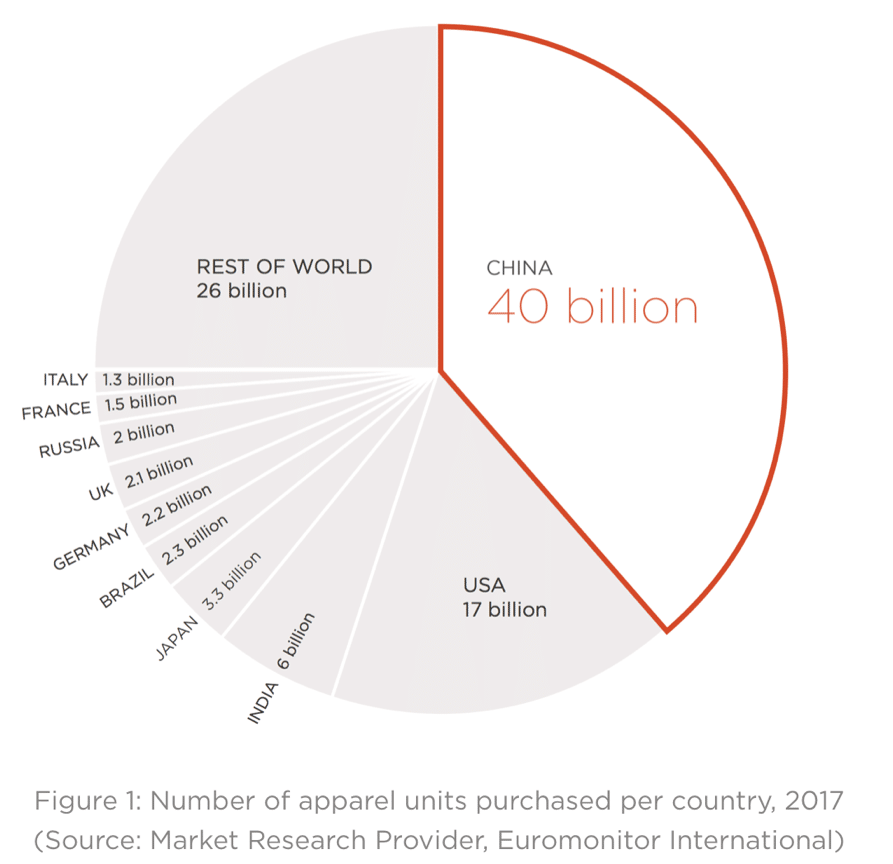Textile and clothing recycling has the potential to alleviate fast fashion problems and absorb some of its impact on the environment. In Hong Kong, the Research Institute for Textiles and Apparel (HKRITA) has developed a revolutionary technique to turn old garments into brand-new clothing, and both the H&M Foundation and the Hong Kong government are betting on it. However, the lengthy process and the discouraging figures related to global fashion waste are making experts and environmentalists question the real impact of such technology.
—
With a market value of US$3,000 billion, the fashion industry accounts for 2% of the world’s Gross Domestic Product (GDP). The sector, which has grown at an unprecedented pace over the past few decades, sees the US and China as its undisputed leaders. The latter currently accounts for the largest fashion market and e-commerce sector in the world and is the leading exporter of apparel worldwide, besides dominating the ranking for retail purchasing worldwide.
In 2020, the average Chinese consumer spent around RMB$1,645 (approximately US$260) on clothes and footwear. However, it is US consumers who purchase most items. On average, a US consumer is estimated to buy one item of clothing per week or 53 garments per year. Along with other nine countries – India, Japan, Germany, the United Kingdom, Russia, France, Italy, and Brazil – China and the US account for three-quarters of all clothes sold each year worldwide.

Image: Common Objective
The explosion in consumption and the rising purchasing rates of consumers are the root of the planet’s environmental crisis and the main drivers of fast fashion problems and the climate crisis. In recent years, new regulatory frameworks from governments worldwide as well as the pressure from increasingly environmentally conscious consumers have pushed fashion and e-commerce companies to put sustainability at the top of their agenda, developing strategies to achieve carbon neutrality and other green goals and thus reducing the devastating environmental impact of the fashion industry. Indeed, from the manufacturing and shipping of clothes to the vast amount of clothes thrown away every year – 26 million tons in China alone – the environmental cost of fashion is huge and accounts for approximately 10% of global carbon emissions.
You might also like: Fast Fashion: Its Detrimental Effect on the Environment
Some of the world’s largest clothing retailers have launched eco-friendly fashion lines and have adopted other strategies with the aim of showcasing developments in sustainable fashion. One of them is the Swedish multinational H&M. The world’s second largest global clothing retailer – known for its affordable fast-fashion clothing – started non-profit H&M Foundation in 2014 to improve humanitarian and environmental issues within the fashion industry. It was initiated – as the Foundation states on its website – “to co-create, fund and share solutions for the world’s most urgent challenges” and “help safeguard the welfare of humanity” by promoting a “planet positive fashion future”. One of its core projects is promoting innovative technologies to recycle clothes.
The most prominent and successful example comes from the foundation’s partnership with the Hong Kong Research Institute of Textiles and Apparel (HKRITA), the world’s first facility to turn recycled fabrics into new clothes.
Hong Kong’s clothing industry is one of the most important manufacturing sectors, with a total of 490 establishments and nearly 3,000 workers as of 2020. Apart from production, the city is big on sourcing clothing, from fabrics procurement and clothing design to sales, marketing, and quality control. The nearly 13,000 garment companies across the territory helped turn Hong Kong into the 12th largest exporter of clothing worldwide. In recent years, the city has also emerged as a research and development (R&D) and commercialisation hub for sustainable fashion technologies, with the partnership between HKRITA and H&M Foundation leading the way.
One of the most innovative projects brought on by HKRITA is the ‘Green Machine’, an innovative hydrothermal separation treatment that can recycle blend textiles into new clean and wearable fibres without any quality loss. Requiring only heat and very little biodegradable green chemical, the method assures that no secondary pollution is created during the recycling process.
Fashion brand Monki was the first to release a sustainable collection with recycled textile materials created by the Green Machine. First tested in Hong Kong, this technology has now scaled up in Indonesia and H&M Foundation bets that it could eventually solve some of the industry’s biggest environmental problems. For this reason, it has invested millions of dollars in HKRITA. Along with the financial support of the Innovation and Technology Fund of the Hong Kong SAR, this money is helping finance a four-year project that aims at discovering and developing other groundbreaking sustainable recycling technologies as well as scaling up the hydrothermal system.
HKRITA also developed another system that does more than just recycle clothes. The award-winning Garment to Garment (G2G) Recycling System is a mini-scale, environmentally-friendly production line that recycles post-consumer garments into new ones adopting a mechanical treatment that does not require any water or chemical. The partnership with the H&M Foundation brought this system one step forward, by installing it in community spaces such as retail shops to showcase the garment recycling process to the public and most importantly to educate consumers on the immense value of clothes and the importance of recycling them. The “Looop” – the retail model of the G2G Recycling System – was first installed in one of H&M’s stores in Stockholm, Sweden, in 2020.
There are, however, some downsides to this brand new technology. First, it takes approximately three days for the Looop recycling system to turn a garment into a new piece of clothing the size of a child’s t-shirt. Business Insider argues that it would take almost 50,000 years for the Looop recycling system to recycle just one week worth of waste from the fashion market. Furthermore, even though not many materials and products are required to turn old textiles into clothes, the lengthy process is also inevitably requiring huge amounts of energy. But the experts’ main issue is that the commitment of big fast-fashion retailers to recycling and other sustainable initiatives does not solve the core problems of what the retailer is promoting in the first place: fast fashion.
Even though the promising partnership could lead to a revolution of textile recycling techniques in the long run, behind it there is still a company that promotes overconsumption in the first place. Additionally, environmentalists argue other issues such as child labour and poor working conditions typically associated with the fast fashion market would also not be solved.
What HKRITA’s small-scale retail model is doing in terms of promoting recycling and educating consumers on its importance is certainly a first step in the right direction and fast-fashion brands jumping on the sustainability wagon is great news. However, the main issue remains: there is simply too much clothing. Unless societies shift away from overconsumption and fast fashion retailers make room for smaller, more sustainable brands that produce more durable clothing with better fabrics, the fashion industry will not cease to damage the environment.
Featured image: H&M Foundation
You might also like: 6 Biggest Environmental Issues in Hong Kong in 2023


















